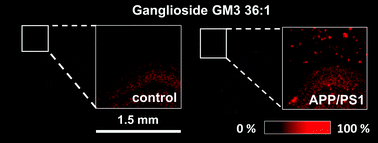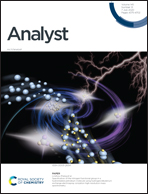Mass spectrometry imaging of free-floating brain sections detects pathological lipid distribution in a mouse model of Alzheimer's-like pathology†
Abstract
Mass spectrometry imaging (MSI) is a modern analytical technique capable of monitoring the spatial distribution of compounds within target tissues. Collection and storage are important steps in sample preparation. The recommended and most widely used preservation procedure for MSI is freezing samples in isopentane and storing them at temperatures below −80 °C. On the other hand, the most common and general method for preserving biological samples in clinical practice is fixation in paraformaldehyde. Special types of samples prepared from these fixed tissues that are used for histology and immunohistochemistry are free-floating sections. It would be very beneficial if the latter procedure could also be applicable for the samples intended for subsequent MSI analysis. In the present work, we optimized and evaluated paraformaldehyde-fixed free-floating sections for the analysis of lipids in mouse brains and used the sections for the study of lipid changes in double transgenic APP/PS1 mice, a model of Alzheimer's-like pathology. Moreover, we examined the neuroprotective properties of palm11-PrRP31, an anorexigenic and glucose-lowering analog of prolactin-releasing peptide, and liraglutide, a type 2 diabetes drug. From the free-floating sections, we obtained lipid images without interference or delocalization, and we demonstrated that free-floating sections can be used for the MSI of lipids. In the APP/PS1 mice, we observed a changed distribution of various lipids compared to the controls. The most significant changes in lipids in the brains of APP/PS1 mice compared to wild-type controls were related to gangliosides (GM2 36:1, GM3 36:1) and phosphatidylinositols (PI 38:4, 36:4) in regions where the accumulation of senile plaques occurred. In APP/PS1 mice peripherally treated with palm11-PrRP31 or liraglutide for 2 months, we found that both peptides reduced the amount and space occupied by lipids, which were linked to the senile plaques. These results indicate that palm11-PrRP31 as well as liraglutide might be potentially useful in the treatment of neurodegenerative diseases.



 Please wait while we load your content...
Please wait while we load your content...